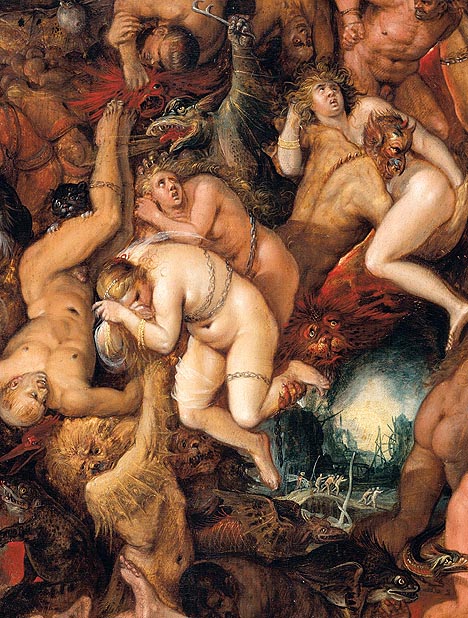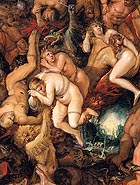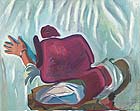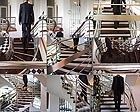
translated and summarized by: Liz Wollner-Grandville,
English summary September 8 - 14
Residenzgalerie Salzburg: Sin. Sweet vice – Venial morale in fine arts
Indoctrination, not prurience
Only a few feet away from the Domplatz in Salzburg, where “Jedermann” is performed during the Salzburg Festival, you encounter the topics sin, vice, and virtues in art at the Residenzgalerie. This recurrent theme, which seems to combine allegorical figures from the play with the depiction of the seven sins, is found on an advertisement: the word "sin", in large red letters, above a naked, lasciviously draped odalisque reminds of stencils reading “censored”. But those who think they might be able to secretly indulge in sin at this exhibit will be disappointed. This exhibit is all about indoctrination, not prurience. The woodcut created around 1480 or 1490 titled “The seven mortal sins and the devil” was meant to intimidate those who intended to leave the path of virtue.
In the 17th century the consumption of tobacco (smoking and sniffing) was seen as a sign of idleness and not as a means to relax. If one had known back then that smoking causes vascular problems and is more addictive than alcohol, painters like Theodor Rombouts or Gerard van Honthorst would have depicted a man with an amputated leg rather than pipe smoking, card-playing drunkards in a pub.
Today students from the technical college in Salzburg show us what they perceive as sin and vice. And their creations, not only from an art historical perspective, take us miles away from the Fall of Man and the banishment from paradise, as well as Alfred Kubin’s gripping depictions.
The light red coloring of the walls, non-intrusively composed with alternating colors, is remarkably well chosen. The explanations may be informative, but they are not sufficiently satisfying. Could too much thirst for knowledge be indecent?
Residenzgalerie Salzburg
5010 Salzburg, Residenzplatz 1, until 02.11.08
www.residenzgalerie.at
Kunstmuseum Winterthur: Giorgio de Chirico. Works from 1909 – 1971 from Swiss collections
“Pictor Optimus”
Lack of self-confidence was never Giorgio de Chirico’s problem. In a self-portrait dating from 1911, when he was only 23 years old, he imitated Friedrich Nietzsche’s pose in his famous portrait photo. Later he described himself as “Pictor Optimus” or titled them as “eternal fame may be bestowed on me, so I will be praised at all times” (in this case a quote by Ovid).
The exhibit in Winterthur clearly shows that de Chirico, with his references to the antique or the Renaissance and Baroque, looked back more into the past than into the future; as opposed to his contemporaries, who preferred to perceive themselves as part of a collective, as random generators, or as engineers rather than as masters of art like de Chirico. His paintings show battered gladiators resting after fierce fights or crumbling arcade walls. Not only the metaphysical art (pittura metafisica) with its wide, indeterminate squares, its dark drop shadows and its assembled figures made up of geometrical elements or architectural pledges is presented, but also his later, rather pompous paintings, whose vibrant surface reminds of Renoir’s late works. An exhibit, which claims to be a retrospective, is not allowed to ignore these rather disconcerting aspects. Financial problems could be responsible for the fact that de Chirico reanimated his pittura metafisica towards the end of his career. His cryptic painting “Bagni misteriosi”, in which people sit and stand in baths, is enthralling - even today.
Kunstmuseum Winterthur
8402 Winterthur, Museumstrasse 52, until 22.11. 2008
www.kmw.ch
Werner Berg Galerie der Stadt Bleiburg/Kärnten, Künstlerhaus Klagenfurt – Kunstverein Kärnten, Alpen-Adria-Galerie, Museum des Nötscher Kreises, Kelag-Schau-Kraftwerk Forstsee, Krastal, Napoleonstadel – Kärntens Haus der Architektur:
K08: Emancipation and Confrontation – Art from Carinthia from 1945 to this day
Down south
The trend to organize cultural events at a number of locations rather than just one centralized site is currently en vogue. The Manifesta 7 took place in four cities in the region of Trentino – South Tyrol, Italy and the Austrian art events “Viertel-Festival” as well as the “Festival der Regionen” is organized at numerous locations. The “Regionale08”, held for the first time this year in the province of Styria, took place at more than two dozen different venues east of Graz showing 35 events. And the first comprehensive exhibit on “Art from Carinthia from 1945 to this day”: the "K08: Emancipation and Confrontation”, follows a similar concept.
Not only strategic, but also cultural policies are the driving forces behind this idea. It is somewhat surprising – at least at first sight – that it was possible to find such a broad platform and enough financial support to exhibit contemporary art in Carinthia, often nicknamed “Haider-Land” referring to its right-wing governor Jörg Haider. Only ten years ago, Haider fervently fought against contemporary art and even impeded the renovation of the Kolig-hall in the Carinthian state assembly (Landtag). Silvie Aigner, the neutral and competent curator of this event, is definitely to be thanked that this exhibit is free of political influence.
K08 is held in nine museums and art associations in six different locations, ranging from the regions Nötsch in the west of Carinthia to the town of Bleiburg. In addition, Aigner invited 10 private galleries to participate in the K08.
Aigner did not set any priorities as to the origin of the artists. She focused on the connection between the biography of an artist and art – art shown within and beyond Carinthian boundaries. This granted the K08 a much broader socio-historical dimension.
To name some examples: Werner Berg, born 1904 in Wuppertal, Germany, who moved to Carinthia in 1931, where he lived on a farm, and was an active mediator between the German-speaking and the Slovenian cultural groups. Or Arnulf Rainer, born 1929 in Baden, Austria, who studied at the Gewerbeschule (industrial school) in Villach, Carinthia from 1947 – 1949. Here he met Maria Lassnig with whom he traveled to Paris in 1951.
The comprehensive exhibit at the MMKK in Klagenfurt, which constitutes the historical linchpin of the K08 project, clearly communicates the complexity of this phase, which reaches far beyond the Carinthian boundaries. Here you can view sculptures by the Wotruba students Otto Eder, Anton Marcolin, Othmar Jaindl, and drawings as well as paintings created in the 50s and 60s by Lassnig, Eder, Rainer, Kogelnik, Staudacher, and Fruhmann. Objects by Bruno Gironcolli and sculptures by Cornelius Kolig’s as well works by Kurt “Kappa” Kocherscheidt, Reimo Wukounig, and Viktor Rogy’s conceptual art are also displayed.
The Alpe Adria Gallery presents painting and video works with an architectural focus by Hubert Lobnig and Birgit Knoechl, while the Kunstverein displays contemporary tendencies in photography, installations, sculptures, media- and object art (Ines Doujak, Josef Dabernig, Anja Manfredi, Roland Kollnitz, Six & Petritsch, Luisa Kasalitzky, and many more). The Napoleonstadel attempts to communicate the international networking of architecture with a huge air ball installation by SHARE Architects.
The exhibits outside of Klagenfurt include the Werner Berg Museum in Bleiburg, which focuses on constructive, concrete and geometrical tendencies in works by Berg, Bischoffshausen, Hollegha, Kogelnik, Kaufmann, Zobernig, Penker, and Plieschnig to the younger artists such as Manuel Knapp, Suse Krawagna, and Eric Kressnig. The Museum of the Nötscher Kreis in contrast shows works by Franz Grabmayr, Karl Stark, Hugo Wulz, Helga Druml, Alina Kunitsynas, Markus Orsini-Rosenberg and Richard Klammer.
Werner Berg Galerie der Stadt Bleiburg, Carinthia
9150 Bleiburg, 10.- Oktober-Platz 4, until 02. 11. 2008
www.berggalerie.at
Künstlerhaus Klagenfurt – Kunsterverein Kärnten
9020 Klagenfurt, Goethepark 1, until 02.11.2008
www.kunsterveinkaernten.at
Museum Moderner Kunst Kärnten (MMKK)
9020 Klagenfurt, Burggasse 8/Domgasse, until 02.11.2008
www.mmkk.at
Alpen-Adria-Galeria
9020 Klagenfurt, Theaterplatz 3, until 02.11.2008
www.stadtgalerie.net
Museum des Nötscher Kreises
9611 Nötsch im Gailtal, Haus Wiegele im Gailtal 39, until 02.11.2008
www.noetscherkreis.at
Kelag-Schau-Kraftwerk Forstsee
On the banks of Wörthersee between Pörtschach and Velden,
Until 02.11.2008
www.kelag.at
Krastal
9541 Einöde near Villach, Krastalerstrasse 24, until 02.11.2008
www.krastal.com
Napoleonstadel – Kärntens Haus der Architektur
9020 Klagenfurt, St. Veiter Ring 10, until 02.11.2008
www.architektur-kaernten.at
Mehr Texte von translated and summarized by: Liz Wollner-Grandville


 Teilen
Teilen




